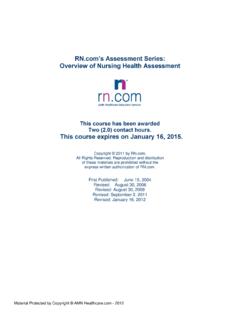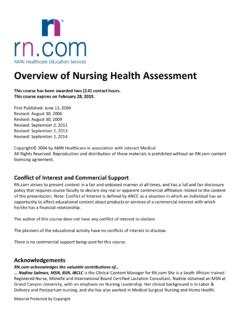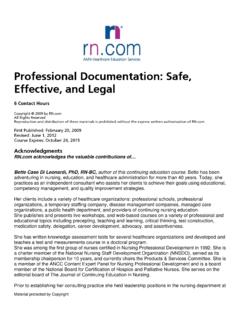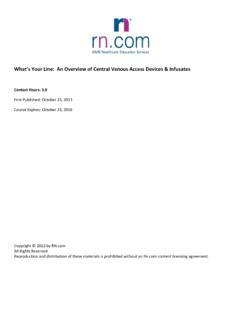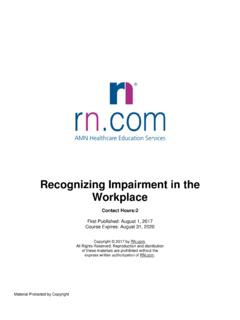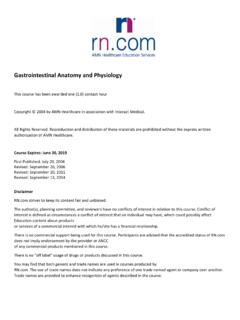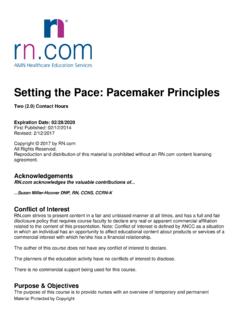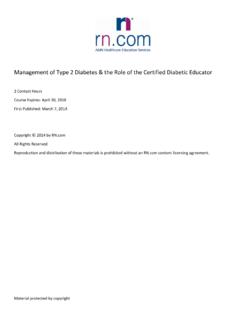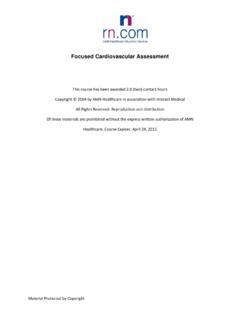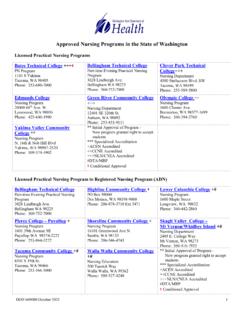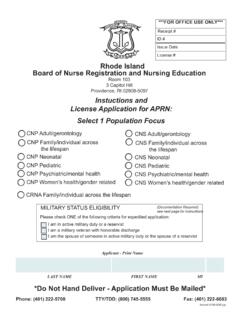Transcription of Lab Values: Interpreting Chemistry and Hematology ... - …
1 Material protected by Copyright Lab Values: Interpreting Chemistry and Hematology for Adult Patients 2 Contact Hours Copyright 2011 by All Rights Reserved Reproduction and distribution of these materials is prohibited without the express written authorization of First Published: March 30, 2012 Course Expires: March 30, 2015 Material protected by Copyright Acknowledgments acknowledges the valuable contributions Kim Maryniak, RNC-NIC, BN, MSN has over 22 years staff nurse and charge nurse experience with med/surg, psychiatry, pediatrics, including 13 years in neonatal intensive care.
2 She has been an educator, instructor, and nursing director. Her instructor experience includes maternal/child and med/surg nursing , physical assessment, and research utilization. Kim graduated with a nursing diploma from Foothills Hospital School of nursing in Calgary, Alberta in 1989. She achieved her Bachelor in nursing through Athabasca University, Alberta in 2000, and her Master of Science in nursing through University of Phoenix in 2005. Kim is certified in Neonatal Intensive Care nursing and is currently pursuing her PhD in nursing .
3 She is active in the National Association of Neonatal Nurses and American Nurses Association. Kim s recent roles in professional development and management include neonatal and pediatric care, nursing peer review and advancement, teaching, and use of simulation. Disclaimer strives to keep its content fair and unbiased. The author(s), planning committee, and reviewers have no conflicts of interest in relation to this course. There is no commercial support being used for this course. Participants are advised that the accredited status of does not imply endorsement by the provider or ANCC of any commercial products mentioned in this course.
4 There is "off label" usage of medications discussed in this course. You may find that both generic and trade names are used in courses produced by The use of trade names does not indicate any preference of one trade named agent or company over another. Trade names are provided to enhance recognition of agents described in the course. Note: All dosages given are for adults unless otherwise stated. The information on medications contained in this course is not meant to be prescriptive or all-encompassing.
5 You are encouraged to consult with physicians and pharmacists about all medication issues for your patients. Material protected by Copyright Purpose The purpose of this continuing education module is to provide nurses with the knowledge and skills to recognize changes in common Chemistry and complete blood count lab values. Additionally, after completing this module, you will be able to discuss reasons why these common lab values may be either elevated or decreased. Learning Objectives After successful completion of this course, you will be able to.
6 Identify normal Chemistry values for the adult patient Define the normal range of laboratory values for components of a complete blood count for the adult patient Explain at least two causes and complications of abnormal Chemistry values and complete blood count Identify at least one treatment associated with abnormal findings Material protected by Copyright Introduction Using laboratory values can be a key piece of assessment to determine what is occurring within the body of a patient. There are numerous laboratory tests that can be done.
7 The most common tests include Chemistry panels, Hematology (such as the complete blood count), and blood gases. This course will take a closer look at these components. Lab values for this course are taken from the Rush Medical Laboratory (Rush University Medical Center, 2012). Remember that there is some variation in ranges based on the laboratory, so be aware of the normal ranges for your facility. Introduction to Electrolytes Electrolytes The human body is constantly trying to keep a balance of homeostasis with fluid and electrolytes.
8 Electrolytes are chemical compounds that break down into ions, carrying a positive or negative charge. When these are not in balance, pathological changes occur in the human body (LeFever, Paulanka, & Polek, 2010). Sodium (Na+) Sodium (Na+) is the major component of extracellular fluid (ECF). The normal values are 137-147 mmol/L Na+ takes part in the regulation of acid-base balance, tissue osmolality and enzyme activity. Na+ is also essential for the retention of body water by maintaining osmotic pressure (LeFever, Paulanka, & Polek, 2010).
9 Potassium (K+) Potassium (K+) is the major component of intracellular fluid (ICF). The normal value range is mmol/L. K+ participates in enzyme activity, regulation of tissue osmolality and glycogen use. K+ is also essential for cardiac function and central nervous system function by regulating muscle and nerve excitability (LeFever, Paulanka, & Polek, 2010). Chloride (Cl-) Chloride (Cl-) is another component of ECF, with normal values between 99-108 mmol/L. Cl- participates in tissue and cell osmolality, and passively follows sodium and water.
10 Cl- is necessary for K+ retention, transport of carbon dioxide (CO2), and formation of hydrochloric acid (HCL) in the gastrointestinal tract. Cl- is usually provided in the form of NaCl or KCl (LeFever, Paulanka, & Polek, 2010). Material protected by Copyright Magnesium (Mg2+) Magnesium (Mg2+) is found in the bone (50%), the ICF (45%), and the ECF (5%). The normal range is mg/dL. Mg2+ affects enzyme activity, cardiac and neuromuscular function. Deficits with Mg2+ are usually seen with deficits in Ca2+ and/or K+ (LeFever, Paulanka, & Polek, 2010).
